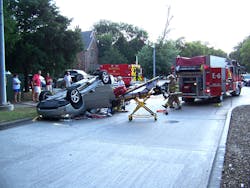University of Extrication: Pickup Truck & SUV Skills Refresher—Part 5
Topic: Pickup truck and sport utility vehicle (SUV) refresher
Objective: Incident management skills at SUV rollover incidents
Task: Given a case study of an SUV rollover incident, the rescue team will review the skills typically employed at rollover incidents and revise or update these skills accordingly.
Our pickup truck and SUV series has so far addressed the unique airbags in these vehicles, how to work with jammed rear-hinged rear doors, dealing with the high ground clearance typically found when a pickup or SUV is involved in an incident, and special stabilization techniques when running boards are present. In Part 5, we address several incident management skills at a rollover incident using a real-world example of an SUV entrapment situation.
Initial actions
Incident management begins as the first crew arrives at this intersection crash. The company officer of the first-due company establishes Command and begins a walk-around size-up of the situation.
The officer discovers that the driver of the four-door sedan that crashed into the Lexus SUV is still seated inside. The vehicle is sitting in the middle of the intersection, and the driver’s door is already open. One responder chocks the drive wheels, places the vehicle in park, turns off the ignition and makes patient contact.
Size-up of the roof-resting SUV reveals that one person is trapped—the driver, who is belted and suspended upside-down in the vehicle. The engine is not running, there are no apparent fluid leaks, and both headlights are shining on the roadway, indicating that the electrical system and possibly the ignition are still on. The roof airbag on the drivers’ side has deployed and is now deflated along the roofline.
Control the situation
Hazard control must include traffic management, work to turn off the ignition, shutting down the 12-volt power, and stabilization of the roof-resting SUV. The battery of a Lexus RX-model SUV is under the hood on the drivers’ side. If Command has personnel available, a team can be assigned to work through the fender or wheelwell to attempt to access the actual battery once the vehicle is stabilized.
A standby hoseline is stretched as traffic control is established. Stabilization efforts utilize step chocks, cribbing, struts and chain to secure the vehicle as found. Command decides not to access the battery at this time, and everyone on the rescue team is notified that they will be working on a “hot” car, meaning the 12-volt electrical system is energized.
Access to the patient is gained through the already opened passenger side front and rear doors. Medical responders go inside, make patient contact and report a stable patient.
There is a need to open the driver’s front door, but trying either the inside or outside door handles proves unsuccessful. This door will have to be forced open and either widened or removed entirely.
An extrication crew sets up the door, forces it open at the latch and then removes the door completely. The patient is now visible from the driver’s side of the vehicle.
A longboard is used by crewmembers inside and outside of the SUV. In a coordinated effort, they put the board under the patient, lift the board and the inverted patient upward slightly, release the seatbelt/shoulder harness and lower the patient face down onto the longboard.
The patient comes out of the vehicle on the board, is rolled onto another board so they are face up and then transferred to the ambulance stretcher.
In sum
Pickup truck and SUV rollover incidents, whether the vehicle is side-resting or roof-resting, need to be an integral part of our extrication training. Extricating a seated and belted patient in a rollover crash, such as our case study, or when the training vehicle is side-resting, involves skills that can easily be practiced using a mannequin to play the role of your patient.
SIDEBAR:
Incident Management Considerations for an SUV Rollover
- Establish Command
- Perform scene size-up
- Provide hazard control, including stabilization
- Gain patient access
- Begin extrication
About the Author
Ron Moore
RON MOORE, who is a Firehouse contributing editor, recently retired as a division chief with the McKinney, TX, Fire Department and now serves with Prosper, TX, Fire Rescue. He self-published the Vehicle Rescue 1-2-3 training manual and serves as the forum moderator for the extrication section of Firehouse.com . Moore can be contacted directly at [email protected].

